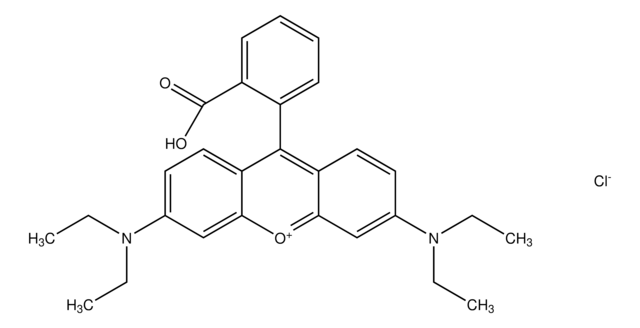02558
Rhodamine B solution
0.2% in isopropanol, for TLC derivatization
About This Item
Productos recomendados
grado
for TLC derivatization
Nivel de calidad
concentración
0.2% in isopropanol
técnicas
thin layer chromatography (TLC): suitable
densidad
0.79 g/mL at 20 °C
cadena SMILES
[Cl-].CCN(CC)c1ccc2c(OC3=CC(\C=CC3=C2c4ccccc4C(O)=O)=[N+](\CC)CC)c1
InChI
1S/C28H30N2O3.ClH/c1-5-29(6-2)19-13-15-23-25(17-19)33-26-18-20(30(7-3)8-4)14-16-24(26)27(23)21-11-9-10-12-22(21)28(31)32;/h9-18H,5-8H2,1-4H3;1H
Clave InChI
PYWVYCXTNDRMGF-UHFFFAOYSA-N
Categorías relacionadas
Aplicación
Palabra de señalización
Danger
Frases de peligro
Consejos de prudencia
Clasificaciones de peligro
Eye Irrit. 2 - Flam. Liq. 2 - STOT SE 3
Órganos de actuación
Central nervous system
Código de clase de almacenamiento
3 - Flammable liquids
Clase de riesgo para el agua (WGK)
WGK 2
Punto de inflamabilidad (°F)
53.6 °F - closed cup
Punto de inflamabilidad (°C)
12 °C - closed cup
Equipo de protección personal
Eyeshields, Faceshields, Gloves, type ABEK (EN14387) respirator filter
Elija entre una de las versiones más recientes:
¿Ya tiene este producto?
Encuentre la documentación para los productos que ha comprado recientemente en la Biblioteca de documentos.
Los clientes también vieron
Nuestro equipo de científicos tiene experiencia en todas las áreas de investigación: Ciencias de la vida, Ciencia de los materiales, Síntesis química, Cromatografía, Analítica y muchas otras.
Póngase en contacto con el Servicio técnico













